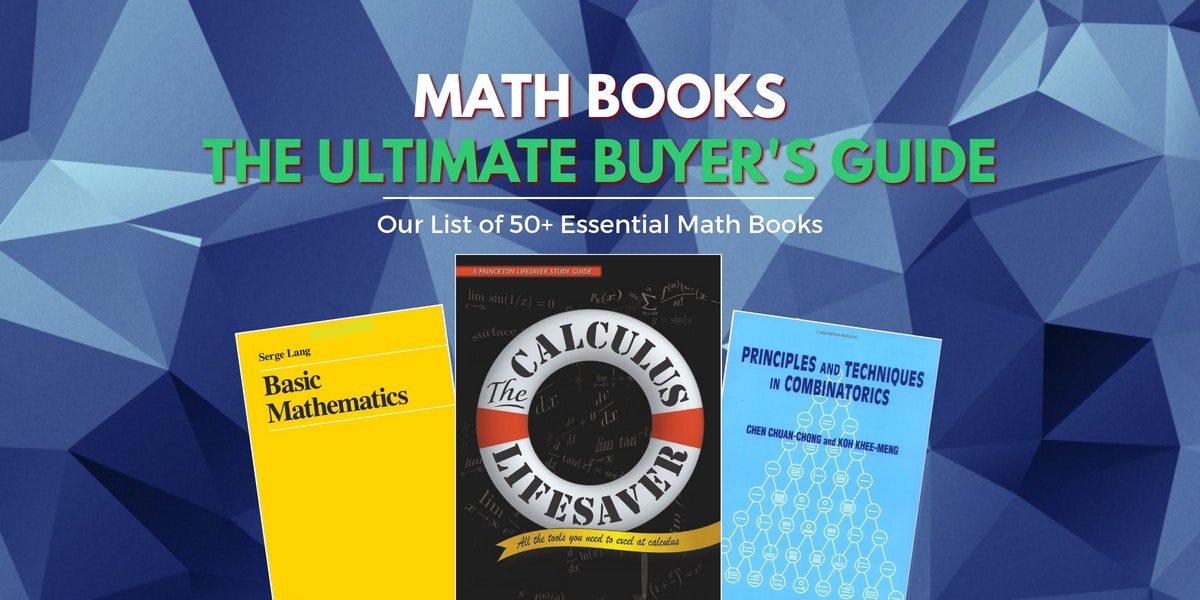Countless math books are published each year, however, only a tiny percentage of these titles are destined to become the kind of classics that are loved the world over by students and mathematicians.
Within this page, you’ll find an extensive list of math books that have sincerely earned the reputation that precedes them.
For many of the most important branches of mathematics, we’ve provided what we consider to be the best math books for the subject at hand. We aimed for a list of titles that were either introductory in nature or that fall into the category of “must-have” math reference books.
Naturally, a universal consensus doesn’t exist but the books below are as close as it gets to a wish list for any aspiring mathematician or person who’s interested in mathematics. We highly recommend each and every one of these titles and hope that you’ll enjoy them, too.
Please note, this list will constantly be updated so as to keep it current.
MATH BOOKS MENU
- Abstract Algebra
- Algorithms
- Calculus Helpers
- Calculus I
- Calculus II
- Coffee Table
- Combinatorics
- Differential Equations
- Encyclopedias of Mathematics
- Foundations of Mathematics
- History of Mathematics
- Information Theory
- Linear Algebra and Geometry
- Mathematical Methods
- Numerical Analysis
- Number Theory
- Precalculus
- Probability
- Real and Complex Analysis
- Statistics
- Topology
Abstract Algebra Books
Contemporary Abstract Algebra
by Joseph Gallian
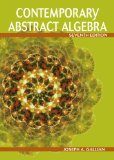 Review: The seventh edition of Contemporary Abstract Algebra covers the basics of abstract algebra with clarity and a rarely seen brightness. Opting for readability over the rigor many of its contemporaries embrace, this textbook provides an excellent starting point for any student looking to learn and understand the subject. Gallian’s writing is inviting and comprehensive, the proofs are rock-solid, and his overall handling of the topic and the reader is gentle – something beginners will be grateful for. Abundantly filled with exercises, well chosen examples, and even biographies on notable mathematicians, this book makes the perfect companion for both students and teaching
Review: The seventh edition of Contemporary Abstract Algebra covers the basics of abstract algebra with clarity and a rarely seen brightness. Opting for readability over the rigor many of its contemporaries embrace, this textbook provides an excellent starting point for any student looking to learn and understand the subject. Gallian’s writing is inviting and comprehensive, the proofs are rock-solid, and his overall handling of the topic and the reader is gentle – something beginners will be grateful for. Abundantly filled with exercises, well chosen examples, and even biographies on notable mathematicians, this book makes the perfect companion for both students and teaching
assistants. More info.
Abstract Algebra
by David S. Dummit and Richard M. Foote
 Review: Serious math learners will be thrilled by the rigorous conciseness of this textbook. Dense with information on every page and presented in a relaxed, open manner, Dummit and Foote’s Abstract Algebra effectively works to usher the reader into a realm of sophisticated algebraic concepts and theories. It seamlessly bridges any gap between graduate and undergraduate studies. The book is chock-full of clear examples and succinct proofs, making it evident that the authors have no intention of keeping the reader on a particular topic any longer than is necessary. With countless exercises and examples, Abstract Algebra proves to be an invaluable tool that is undeniably worth the price. More info.
Review: Serious math learners will be thrilled by the rigorous conciseness of this textbook. Dense with information on every page and presented in a relaxed, open manner, Dummit and Foote’s Abstract Algebra effectively works to usher the reader into a realm of sophisticated algebraic concepts and theories. It seamlessly bridges any gap between graduate and undergraduate studies. The book is chock-full of clear examples and succinct proofs, making it evident that the authors have no intention of keeping the reader on a particular topic any longer than is necessary. With countless exercises and examples, Abstract Algebra proves to be an invaluable tool that is undeniably worth the price. More info.
Algorithms Books
Introduction to Algorithms, Third Edition
by Thomas H. Cormen, Charles E. Leiserson and Ronald L. Rivest
 Review: Introduction to Algorithms is a distinctly theoretical but all-around comprehensive book. Its use is not only limited to those taking algorithms courses but can also be utilized by anyone as an extensive reference source. Readers will learn quintessential algorithms as well as concepts such as what makes an algorithm efficient and why. Students will need a bit of mathematical background to get from cover to cover, however those who are able to do so will be intrigued by the content depth and wide spectrum of topics covered. These topics run the gamut from classical algorithms to computational geometry. More info.
Review: Introduction to Algorithms is a distinctly theoretical but all-around comprehensive book. Its use is not only limited to those taking algorithms courses but can also be utilized by anyone as an extensive reference source. Readers will learn quintessential algorithms as well as concepts such as what makes an algorithm efficient and why. Students will need a bit of mathematical background to get from cover to cover, however those who are able to do so will be intrigued by the content depth and wide spectrum of topics covered. These topics run the gamut from classical algorithms to computational geometry. More info.
The Art of Computer Programming, Volumes 1-3 Boxed Set
by Donald E. Knuth
 Review: This 3 volume box set does a marvelous job of covering subjects in the vast field of computer science. The writing is intact and brimming with mathematical rigor. Readers whose sole focus is learning can easily skim over areas that are excessively detailed without losing grasp of the core concepts. All three volumes are equally definitive and provide a clean theoretical explanation of fundamentals of computer science. The entire set is organized into six chapters: Basic Concepts, Information Structures, Random Numbers, Arithmetic, Sorting, and Searching. Additionally, each chapter section comes with questions students can use to gain better hands on experience. This is book is akin to the bible for computer scientists. A fourth volume is also available. More info.
Review: This 3 volume box set does a marvelous job of covering subjects in the vast field of computer science. The writing is intact and brimming with mathematical rigor. Readers whose sole focus is learning can easily skim over areas that are excessively detailed without losing grasp of the core concepts. All three volumes are equally definitive and provide a clean theoretical explanation of fundamentals of computer science. The entire set is organized into six chapters: Basic Concepts, Information Structures, Random Numbers, Arithmetic, Sorting, and Searching. Additionally, each chapter section comes with questions students can use to gain better hands on experience. This is book is akin to the bible for computer scientists. A fourth volume is also available. More info.
Calculus Helpers Books
The Calculus Lifesaver: All the Tools You Need to Excel at Calculus
by Adrian Banner
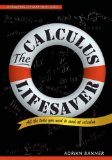 Review: Lengthy yet vital, this resource book is jam packed with straight-forward explanations and loads of solved problems for students to easily learn from. Excelling many of its contemporaries by leaps and bounds, The Calculus Lifesaver truly lives up to its title. Students who are tired of dreary calculus textbooks that provide no motivation behind the concepts will be gladly surprised by the detailed and informal approach Banner uses to capture their attention. He fills all gaps and leaves readers feeling satisfied and enlightened. This book dually holds the characteristics of both an instructive primary aid as well as that of a supplementary read. More info.
Review: Lengthy yet vital, this resource book is jam packed with straight-forward explanations and loads of solved problems for students to easily learn from. Excelling many of its contemporaries by leaps and bounds, The Calculus Lifesaver truly lives up to its title. Students who are tired of dreary calculus textbooks that provide no motivation behind the concepts will be gladly surprised by the detailed and informal approach Banner uses to capture their attention. He fills all gaps and leaves readers feeling satisfied and enlightened. This book dually holds the characteristics of both an instructive primary aid as well as that of a supplementary read. More info.
Calculus Made Easy
by Silvanus P. Thompson
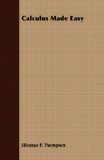 Review: Even those who are not particularly gifted or even proficient in mathematics will enjoy sitting down and studying from Calculus Made Easy. Thompson creates a warm, inviting environment where students will learn and grasp the true essence of calculus without any added fluff or overt technicality. Frustrated students who have sought after a compatible calculus aid to no avail will agree that this is a professional tool that is presented to the reader on the same wavelength. Thompson knows that math is hard. Rather than taking the standard approach that many use to confound and further bewilder students, he breaks calculus down into a form that is a lot less threatening. More info.
Review: Even those who are not particularly gifted or even proficient in mathematics will enjoy sitting down and studying from Calculus Made Easy. Thompson creates a warm, inviting environment where students will learn and grasp the true essence of calculus without any added fluff or overt technicality. Frustrated students who have sought after a compatible calculus aid to no avail will agree that this is a professional tool that is presented to the reader on the same wavelength. Thompson knows that math is hard. Rather than taking the standard approach that many use to confound and further bewilder students, he breaks calculus down into a form that is a lot less threatening. More info.
Calculus I Books
Calculus, Vol. 1
by Tom M. Apostol
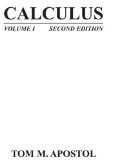 Review: The author strikes a perfect balance between theory and technique by explaining the “why” of calculus in addition to the “how”. He wanders off the standard presentational path for a calculus course and thereby creates a more historically accurate and useful book. Those who are bound by the established method of teaching calculus and are more interested in problems and exercises may not identify with Apostol’s method. But this is a book that was written for the curious student with the intention of being read and understood, not practiced and blindly memorized. The result is that students will be ready to tackle calculus subjects and courses with a newfound clarity. More info.
Review: The author strikes a perfect balance between theory and technique by explaining the “why” of calculus in addition to the “how”. He wanders off the standard presentational path for a calculus course and thereby creates a more historically accurate and useful book. Those who are bound by the established method of teaching calculus and are more interested in problems and exercises may not identify with Apostol’s method. But this is a book that was written for the curious student with the intention of being read and understood, not practiced and blindly memorized. The result is that students will be ready to tackle calculus subjects and courses with a newfound clarity. More info.
Calculus
by Michael Spivak
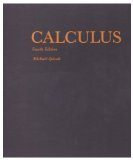 Review: Tenacious students in favor of stimulating study will love this book. Spivak’s prose is almost charming in the way that it thrusts readers into a challenge that advanced learners will be happy to take on. He forces them to rely on their own perspicacity and reason instead of a collection of random techniques and mechanics. Sophisticated readers will appreciate the style he uses to communicate and teach calculus while others may first want to opt for a more elementary text before attempting to penetrate the solidity of Spivak’s. This fourth edition includes additional problems and other minor changes not included in the third. More info.
Review: Tenacious students in favor of stimulating study will love this book. Spivak’s prose is almost charming in the way that it thrusts readers into a challenge that advanced learners will be happy to take on. He forces them to rely on their own perspicacity and reason instead of a collection of random techniques and mechanics. Sophisticated readers will appreciate the style he uses to communicate and teach calculus while others may first want to opt for a more elementary text before attempting to penetrate the solidity of Spivak’s. This fourth edition includes additional problems and other minor changes not included in the third. More info.
Calculus II/III Books
Calculus, Vol. 2
by Tom M. Apostol
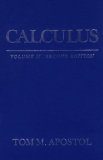 Review: In this follow-up to Volume I of his series, Apostol continues to lay the groundwork for calculus students with precision and ease. Where volume one helped establish the basics and form the reader’s understanding, volume two expands that knowledge in a way that demands full immersion into the text. Unlike other calculus books, this one is replete with substance. The author takes time to build and prove each theorem the way it ought to be done. Unlike many follow-up math books, this one never mindlessly repeats the same material. Instead, it vigorously moves ahead into new territory involving the use of multi-variables and advanced applications. More info.
Review: In this follow-up to Volume I of his series, Apostol continues to lay the groundwork for calculus students with precision and ease. Where volume one helped establish the basics and form the reader’s understanding, volume two expands that knowledge in a way that demands full immersion into the text. Unlike other calculus books, this one is replete with substance. The author takes time to build and prove each theorem the way it ought to be done. Unlike many follow-up math books, this one never mindlessly repeats the same material. Instead, it vigorously moves ahead into new territory involving the use of multi-variables and advanced applications. More info.
Calculus On Manifolds
by Michael Spivak
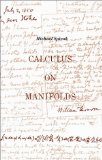 Review: This short and concise book only focuses on what is essential and nothing else. It works to quickly develop the reader’s understanding of differential and integral calculus. Spivak makes his writing on the main objective of the book – Stokes Theorem – painless and easy to grasp. Readers are encouraged to keep a pen and paper on hand to rewrite the proofs on their own. The book’s chapters are as follows: Functions on Euclidean Spaces, Differentiation, Integration, Integration on chains, and Integration on Manifolds. Spivak’s mathematical prowess is apparent by his ability to pack so much punch in only a small amount of pages. If you enjoyed Calculus by Spivak, you’ll love Calculus On Manifolds. More info.
Review: This short and concise book only focuses on what is essential and nothing else. It works to quickly develop the reader’s understanding of differential and integral calculus. Spivak makes his writing on the main objective of the book – Stokes Theorem – painless and easy to grasp. Readers are encouraged to keep a pen and paper on hand to rewrite the proofs on their own. The book’s chapters are as follows: Functions on Euclidean Spaces, Differentiation, Integration, Integration on chains, and Integration on Manifolds. Spivak’s mathematical prowess is apparent by his ability to pack so much punch in only a small amount of pages. If you enjoyed Calculus by Spivak, you’ll love Calculus On Manifolds. More info.
Coffee Table Math Books
Mathematicians: An Outer View of the Inner World
by Mariana Cook
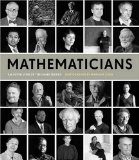 Review: In this uniquely interesting book, photographer Mariana Cook offers readers high quality black and white photographs of 92 noteworthy mathematicians. Cook’s unusual concept for this book has raised several eyebrows. However it provides a much needed break from the rather austere climate that the math world is usually comprised of. Her selected mathematicians come from diverse backgrounds and have all reached their authoritative status in equally different ways. Each photograph is accompanied by a quick, informative and often enlightening essay by the mathematician at hand, frequently revealing the passion and deep love for their discipline that each mathematician possesses. Cook does a wonderful job of capturing her subjects in an honest and purely human light. As such, this title is the ideal coffee table book for math geeks. More info.
Review: In this uniquely interesting book, photographer Mariana Cook offers readers high quality black and white photographs of 92 noteworthy mathematicians. Cook’s unusual concept for this book has raised several eyebrows. However it provides a much needed break from the rather austere climate that the math world is usually comprised of. Her selected mathematicians come from diverse backgrounds and have all reached their authoritative status in equally different ways. Each photograph is accompanied by a quick, informative and often enlightening essay by the mathematician at hand, frequently revealing the passion and deep love for their discipline that each mathematician possesses. Cook does a wonderful job of capturing her subjects in an honest and purely human light. As such, this title is the ideal coffee table book for math geeks. More info.
Sacred Mathematics: Japanese Temple Geometry
by Fukagawa Hidetoshi and Tony Rothman
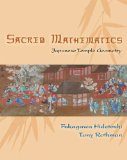 Review: In Sacred Mathematics, Hidetoshi and Rothman present a tantalizing and detailed history of Sangaku puzzles that will keep the reader engaged for many hours. For those who are unfamiliar with the subject, sangakus are Japanese geometrical puzzles that were created on wooden tablets and hung in sacred temples and shrines. Readers will discover how the Japanese cleverly intertwined the mathematical, the spiritual, and the artistic to create their own cultural brand of geometry. Sangaku was formulated during an era before western influence had reached Japan. This makes it a unique and fascinating art that has attracted many mathematicians. The authors do a beautiful job of introducing the reader to Japanese culture and the mastery of the country’s sangakus mathematicians. This hardcover volume is rich of illustrations and would be a nice coffee table book. More info.
Review: In Sacred Mathematics, Hidetoshi and Rothman present a tantalizing and detailed history of Sangaku puzzles that will keep the reader engaged for many hours. For those who are unfamiliar with the subject, sangakus are Japanese geometrical puzzles that were created on wooden tablets and hung in sacred temples and shrines. Readers will discover how the Japanese cleverly intertwined the mathematical, the spiritual, and the artistic to create their own cultural brand of geometry. Sangaku was formulated during an era before western influence had reached Japan. This makes it a unique and fascinating art that has attracted many mathematicians. The authors do a beautiful job of introducing the reader to Japanese culture and the mastery of the country’s sangakus mathematicians. This hardcover volume is rich of illustrations and would be a nice coffee table book. More info.
Combinatorics Books
Principles and Techniques in Combinatorics
by Chen Chuan-Chong and Koh Khee-Meng
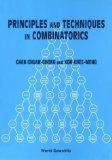 Review: Math undergrads will find Principles and Techniques in Combinatorics to be a detailed but easy to read book. This is a much needed textbook that can truly be classified as introductory. The authors take careful consideration not to over-elaborate key concepts and thereby confuse those readers who are not as advanced in mathematics as others. Students will enjoy walking step by step through precisely detailed combinatorial proofs as well as reading the greatly in depth chapter on Recurrence Relations (Chapter 6). An abundance of combinatorial problems that are perfect for math competition trainers and participants can be found at the end of each chapter, adding even more value to this already low-priced gem. More info.
Review: Math undergrads will find Principles and Techniques in Combinatorics to be a detailed but easy to read book. This is a much needed textbook that can truly be classified as introductory. The authors take careful consideration not to over-elaborate key concepts and thereby confuse those readers who are not as advanced in mathematics as others. Students will enjoy walking step by step through precisely detailed combinatorial proofs as well as reading the greatly in depth chapter on Recurrence Relations (Chapter 6). An abundance of combinatorial problems that are perfect for math competition trainers and participants can be found at the end of each chapter, adding even more value to this already low-priced gem. More info.
Combinatorics and Graph Theory (2nd edition)
by John Harris, Jeffry L. Hirst, and Michael Mossinghoff
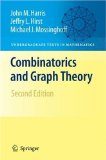 Review: This second edition of Combinatorics and Graph Theory presents all relevant concepts in a clear and straight to-the-point manner that students will undoubtedly favor. The authors waste no time and quickly set out to teach readers in a brilliantly written and warmly engaging manner. Within its 382 pages, students will find unambiguous explanations on a range of combinatorial and graph theory topics such as Ramsey numbers, Cayley’s tree-count theorem, inclusion-exclusion, vertex coloring, and elementary combinations to just name a few. The second edition also contains new material not previously included in the first, such as extended information on Polya theory, stable marriage problems, and Eulerian trails. More info.
Review: This second edition of Combinatorics and Graph Theory presents all relevant concepts in a clear and straight to-the-point manner that students will undoubtedly favor. The authors waste no time and quickly set out to teach readers in a brilliantly written and warmly engaging manner. Within its 382 pages, students will find unambiguous explanations on a range of combinatorial and graph theory topics such as Ramsey numbers, Cayley’s tree-count theorem, inclusion-exclusion, vertex coloring, and elementary combinations to just name a few. The second edition also contains new material not previously included in the first, such as extended information on Polya theory, stable marriage problems, and Eulerian trails. More info.
Differential Equations Books
Differential Equations and Their Applications
by Martin Braun
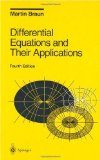 Review: This high-level text is clearly understandable and widely engaging. Braun runs through the pages of his book in a light, expertly written manner that will keep readers hooked for hours. As highly technical as this field is, he covers it fluidly spurring readers to dig deeper into other sources on the subject long after they’ve finished reading this one. Motivated students will find Braun’s discussion insightful, a result of his strive to implement understanding. Anyone taking a course in differential equations for the first time or as a refresher will be greatly pleased by this book’s clear and invigorating approach. More info.
Review: This high-level text is clearly understandable and widely engaging. Braun runs through the pages of his book in a light, expertly written manner that will keep readers hooked for hours. As highly technical as this field is, he covers it fluidly spurring readers to dig deeper into other sources on the subject long after they’ve finished reading this one. Motivated students will find Braun’s discussion insightful, a result of his strive to implement understanding. Anyone taking a course in differential equations for the first time or as a refresher will be greatly pleased by this book’s clear and invigorating approach. More info.
Encyclopedias of Mathematics Books
The Princeton Companion to Mathematics
by Timothy Gowers, June Barrow-Green and Imre Leader (Editors)
 Review: This is an extraordinary book that every student and mathematician should absolutely have. The PCM carries the true signature of a math encyclopedia in that it is versatile and capable of being all things to all learners in every field of mathematics, and on all levels also. In light of its broad spectrum of topics, the editors have managed to keep this book cohesive and well knit together. The PCM includes specialized articles from contributors on a variety of math topics that even the most advanced pros can learn from. Non-mathematicians who are curious about the trade can also learn a great deal of information from the PCM due to its overall accessible nature. This is the kind of book that will still be read a hundred years from now, and it truly is the nicest book I own. More info.
Review: This is an extraordinary book that every student and mathematician should absolutely have. The PCM carries the true signature of a math encyclopedia in that it is versatile and capable of being all things to all learners in every field of mathematics, and on all levels also. In light of its broad spectrum of topics, the editors have managed to keep this book cohesive and well knit together. The PCM includes specialized articles from contributors on a variety of math topics that even the most advanced pros can learn from. Non-mathematicians who are curious about the trade can also learn a great deal of information from the PCM due to its overall accessible nature. This is the kind of book that will still be read a hundred years from now, and it truly is the nicest book I own. More info.
Encyclopedia of Mathematics
by James Stuart Tanton
 Review: This awesome reference gives math lovers exactly what they want from a math encyclopedia. Those who want to quickly search and learn about a particular topic without unneeded rambling from the author or unsatisfactory terseness, will find a trustworthy companion in Tanton’s aptly named work. This book is formatted in an A- Z structure. Tanton makes no diversions in outlining or trying to draw connections other than what is necessary. He essentially gives readers the needed facts and resources, and then keeps it moving. This will prove to be wonderful for some while disappointing for others. The book contains more than 800 entries as well as relevant timelines following the entries. More info.
Review: This awesome reference gives math lovers exactly what they want from a math encyclopedia. Those who want to quickly search and learn about a particular topic without unneeded rambling from the author or unsatisfactory terseness, will find a trustworthy companion in Tanton’s aptly named work. This book is formatted in an A- Z structure. Tanton makes no diversions in outlining or trying to draw connections other than what is necessary. He essentially gives readers the needed facts and resources, and then keeps it moving. This will prove to be wonderful for some while disappointing for others. The book contains more than 800 entries as well as relevant timelines following the entries. More info.
Foundations of Mathematics Books
A Mathematical Introduction to Logic, Second Edition
by Herbert Enderton
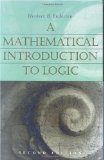 Review: This is one of the finest introductory texts on logic that any student can read. Enderton is cohesive in his explanations and skillfully covers all the essential bases, from number theory to first and second order logic as well as several theorems, including Godel’s. While not a mandatory requirement, it is highly recommended that the reader has a slight understanding of math logic. This will make it easier to complete the many exercises found throughout. Complete with many well-chosen examples and a wider scope than most of its peers, I’d suggest this book to anyone seeking to learn or better understand math logic. More info.
Review: This is one of the finest introductory texts on logic that any student can read. Enderton is cohesive in his explanations and skillfully covers all the essential bases, from number theory to first and second order logic as well as several theorems, including Godel’s. While not a mandatory requirement, it is highly recommended that the reader has a slight understanding of math logic. This will make it easier to complete the many exercises found throughout. Complete with many well-chosen examples and a wider scope than most of its peers, I’d suggest this book to anyone seeking to learn or better understand math logic. More info.
Classic Set Theory for Guided Independent Study
by Derek C. Goldrei
 Review: This is a clearly written and expertly arranged independent study guide designed to make the topic of set theory comprehensible and easy to grasp for self-study students. Without a doubt, this books more than delivers. Readers can expect a smooth ride devoid of complexity and assumed pre-exposure to the subject. Goldrei’s book brings forth an abundance of both solved an unsolved exercises, illustrations and thorough explanations. Ideas, commentaries and recommendations that are resourcefully placed alongside the main text delightfully height the learning experience. This is one of those unfortunately rare but wonderfully rigorous independent study math books that many students stumble across and never seem to put down. More info.
Review: This is a clearly written and expertly arranged independent study guide designed to make the topic of set theory comprehensible and easy to grasp for self-study students. Without a doubt, this books more than delivers. Readers can expect a smooth ride devoid of complexity and assumed pre-exposure to the subject. Goldrei’s book brings forth an abundance of both solved an unsolved exercises, illustrations and thorough explanations. Ideas, commentaries and recommendations that are resourcefully placed alongside the main text delightfully height the learning experience. This is one of those unfortunately rare but wonderfully rigorous independent study math books that many students stumble across and never seem to put down. More info.
Categories for the Working Mathematician
by Saunders Mac Lane
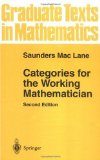 Review: The author of this work, Sunders Mac Lane, has concisely spread out all the vital category theory information that students will probably ever need to know. Category theory is a tough topic for many and is not effortlessly explained. However, Mac Lane approaches the task with skill, dexterity and an orderly flow of writing – but this isn’t surprising being that Mac Lane is the very originator of category theory. Those with limited experience with graduate-level mathematics are cautioned to start with a more basic text before delving into this one. However, serious mathematicians looking to learn from one of the masters in the trade will be thoroughly delighted with Mac Lane’s exposition. More info.
Review: The author of this work, Sunders Mac Lane, has concisely spread out all the vital category theory information that students will probably ever need to know. Category theory is a tough topic for many and is not effortlessly explained. However, Mac Lane approaches the task with skill, dexterity and an orderly flow of writing – but this isn’t surprising being that Mac Lane is the very originator of category theory. Those with limited experience with graduate-level mathematics are cautioned to start with a more basic text before delving into this one. However, serious mathematicians looking to learn from one of the masters in the trade will be thoroughly delighted with Mac Lane’s exposition. More info.
History of Mathematics Books
Mathematics: From the Birth of Numbers
by Jan Gullberg
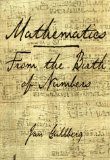 Review: Gullberg’s takes an amazing dive into the deep grounded roots of mathematics and its origins. The astounding part about all of it is that Jan Gullberg is a doctor and not a mathematician. Despite this, he has managed to write a thorough book that captures the entire history of math along with answers to the “why” and “how” that students often ask. The enthusiasm he exhibits throughout will spread onto readers like wildfire. This work is clearly a labor of love, not self-exaltation. Readers will appreciate that Gullberg is simply a man who has fallen in love with and holds an immense adoration for one of the most important components of human civilization. More info.
Review: Gullberg’s takes an amazing dive into the deep grounded roots of mathematics and its origins. The astounding part about all of it is that Jan Gullberg is a doctor and not a mathematician. Despite this, he has managed to write a thorough book that captures the entire history of math along with answers to the “why” and “how” that students often ask. The enthusiasm he exhibits throughout will spread onto readers like wildfire. This work is clearly a labor of love, not self-exaltation. Readers will appreciate that Gullberg is simply a man who has fallen in love with and holds an immense adoration for one of the most important components of human civilization. More info.
What Is Mathematics? An Elementary Approach to Ideas and Methods
by Richard Courant and Herbert Robbins
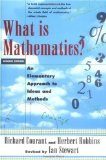 Review: Math aficionados will profit greatly from this book. Those interested in breezing through a math history text won’t however have much luck with this one. That is because this book does more than just skim the surface. The authors prompt readers to actually think about the ideas and methods mentioned rather than blindly swallow them down for later use. They present captivating discussions on many topics instead of dull facts and easy answers. The end result of reading this book is an appreciation that will develop from the thought processes readers are required to use. The writing is classic and elucidating, accompanied by many engaging illustrations and side notes. More info.
Review: Math aficionados will profit greatly from this book. Those interested in breezing through a math history text won’t however have much luck with this one. That is because this book does more than just skim the surface. The authors prompt readers to actually think about the ideas and methods mentioned rather than blindly swallow them down for later use. They present captivating discussions on many topics instead of dull facts and easy answers. The end result of reading this book is an appreciation that will develop from the thought processes readers are required to use. The writing is classic and elucidating, accompanied by many engaging illustrations and side notes. More info.
Mathematics and its History
by John Stillwell
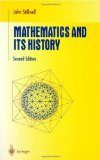 Review: This book contains a treasure chest of priceless history and deep facts that even established pros will find themselves learning from. John Stillwell foregoes the encyclopedic route and makes it his goal to help the reader understand the beauty behind mathematics instead. He brilliantly unifies mathematics into a clear depiction that urges readers to rethink what they thought they knew already. He effectively travels all pertinent ground in this relatively short text, striking a clever balance between brevity and comprehensiveness. Readers looking to truly understand the whole concept of mathematics and its disciplines will enjoy reading Stillwell’s Mathematics and its History. More info.
Review: This book contains a treasure chest of priceless history and deep facts that even established pros will find themselves learning from. John Stillwell foregoes the encyclopedic route and makes it his goal to help the reader understand the beauty behind mathematics instead. He brilliantly unifies mathematics into a clear depiction that urges readers to rethink what they thought they knew already. He effectively travels all pertinent ground in this relatively short text, striking a clever balance between brevity and comprehensiveness. Readers looking to truly understand the whole concept of mathematics and its disciplines will enjoy reading Stillwell’s Mathematics and its History. More info.
Information Theory Books
Computational Science and Engineering
by Gilbert Strang
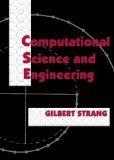 Review: Gilbert Strang has a reputation for writing ample, pragmatic, and insightful books. During the course of reading this one, it will become blatantly clear to the reader that the author has created this work out of passion and a genuine love for the subject. Every engineer can benefit deeply from reading this. Strang’s writing style and his instructive approach are unrivaled. He covers all aspects of computational science and engineering with experience and authority. The topics discussed include applied linear algebra and fast solvers, differential equations with finite differences and finite elements, and Fourier analysis and optimization. Strang has taught this material to thousands of students. With this book many more will be added to that number. More info.
Review: Gilbert Strang has a reputation for writing ample, pragmatic, and insightful books. During the course of reading this one, it will become blatantly clear to the reader that the author has created this work out of passion and a genuine love for the subject. Every engineer can benefit deeply from reading this. Strang’s writing style and his instructive approach are unrivaled. He covers all aspects of computational science and engineering with experience and authority. The topics discussed include applied linear algebra and fast solvers, differential equations with finite differences and finite elements, and Fourier analysis and optimization. Strang has taught this material to thousands of students. With this book many more will be added to that number. More info.
Information Science
by David G. Luenberger
 Review: This book has what many of its peers don’t: the skill and finesse to clearly explain complex concepts in a manner that appeals to readers, but never loses integrity. The book contains interesting historical facts and insightful examples. Luenberger forms the structure of his book around 5 main parts: entropy, economics, encryption, extraction, and emission, otherwise known as the 5 Es. He encompasses several points of view and thereby creates a well-rounded text that readers will admire. He details how each of the above parts provide function for modern info products and services. Luenberger is a talented teacher that readers will enjoy learning from. More info.
Review: This book has what many of its peers don’t: the skill and finesse to clearly explain complex concepts in a manner that appeals to readers, but never loses integrity. The book contains interesting historical facts and insightful examples. Luenberger forms the structure of his book around 5 main parts: entropy, economics, encryption, extraction, and emission, otherwise known as the 5 Es. He encompasses several points of view and thereby creates a well-rounded text that readers will admire. He details how each of the above parts provide function for modern info products and services. Luenberger is a talented teacher that readers will enjoy learning from. More info.
Introduction to Coding and Information Theory
by Steve Roman
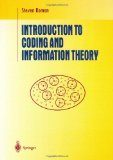 Review: Undergraduate math and computer science students will be thrilled to learn information theory and coding theory from Steve Roman’s book. Readers will gain a profound understanding of the types of codes and their efficiency. Roman starts his exposition off with an introductory section containing brief preliminaries and an introduction to codes that preps the reader and makes it easier for them to process the remaining material. He follows that with two chapters containing a precise teaching on information theory, and a final section containing four chapters devoted to coding theory. He finishes this pleasing journey into information and coding theory with a brief introduction to cyclic codes. More info.
Review: Undergraduate math and computer science students will be thrilled to learn information theory and coding theory from Steve Roman’s book. Readers will gain a profound understanding of the types of codes and their efficiency. Roman starts his exposition off with an introductory section containing brief preliminaries and an introduction to codes that preps the reader and makes it easier for them to process the remaining material. He follows that with two chapters containing a precise teaching on information theory, and a final section containing four chapters devoted to coding theory. He finishes this pleasing journey into information and coding theory with a brief introduction to cyclic codes. More info.
Linear Algebra and Geometry Books
Linear Algebra Done Right
by Sheldon Axler
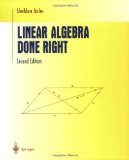 Review: This is an exemplary book requiring a small level of mathematical maturity. Axler takes a thoughtful and theoretical approach to the work. He skillfully takes the focus off from matrices and shifts the reader’s attention more towards linear mappings. This makes his proofs elegant, simple, and pleasing. Conscious of the reader’s possible unfamiliarity as well as time frame, Axler does a fine job of preparing and developing readers’ understanding rather than fully detailing application methods and formulas. He leaves the reader with unsolved exercises which many will find to be thought-provoking and stimulating. An understanding of working with matrices is required. This book works great as a supplementary or second course introduction to linear algebra. More info.
Review: This is an exemplary book requiring a small level of mathematical maturity. Axler takes a thoughtful and theoretical approach to the work. He skillfully takes the focus off from matrices and shifts the reader’s attention more towards linear mappings. This makes his proofs elegant, simple, and pleasing. Conscious of the reader’s possible unfamiliarity as well as time frame, Axler does a fine job of preparing and developing readers’ understanding rather than fully detailing application methods and formulas. He leaves the reader with unsolved exercises which many will find to be thought-provoking and stimulating. An understanding of working with matrices is required. This book works great as a supplementary or second course introduction to linear algebra. More info.
The Four Pillars of Geometry
by John Stillwell
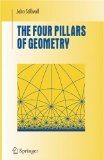 Review: This is a beautifully written book that will help students connect the dots between four differing viewpoints in geometry. These four “pillars”, as Stillwell refers to them, are: straightedge and compass constructions, linear algebra, projective geometry and transformation groups. This book will help the reader develop a stronger appreciation for geometry and its unique ability to be approached at different angles – an exciting trait which ultimately enables students to strengthen their overall knowledge of the subject. Undergraduate students and professors alike will enjoy the brevity of Stillwell’s writing and his ability to rapidly examine each of these topics of geometry rather than emphasize just one. More info.
Review: This is a beautifully written book that will help students connect the dots between four differing viewpoints in geometry. These four “pillars”, as Stillwell refers to them, are: straightedge and compass constructions, linear algebra, projective geometry and transformation groups. This book will help the reader develop a stronger appreciation for geometry and its unique ability to be approached at different angles – an exciting trait which ultimately enables students to strengthen their overall knowledge of the subject. Undergraduate students and professors alike will enjoy the brevity of Stillwell’s writing and his ability to rapidly examine each of these topics of geometry rather than emphasize just one. More info.
Mathematical Methods Books
Mathematical Methods: For Students of Physics and Related Fields
by Sadri Hassani
 Review: This book gives readers an enhanced view of complex mathematics and their applications than most standard courses don’t do. It is recommended that only those with some existing knowledge of linear and complex algebra, differential equations, and even complex analysis and algebra only use this book. Physics and engineering students beyond their introductory courses are the intended audience and will benefit the most. The material can be used as both refresher reading and as a primary study guide. Hassani is well-versed and his
Review: This book gives readers an enhanced view of complex mathematics and their applications than most standard courses don’t do. It is recommended that only those with some existing knowledge of linear and complex algebra, differential equations, and even complex analysis and algebra only use this book. Physics and engineering students beyond their introductory courses are the intended audience and will benefit the most. The material can be used as both refresher reading and as a primary study guide. Hassani is well-versed and his
presentation is expertly organized. He also effectively begins each chapter with a short preamble that helps further instill understanding of the main concepts. More info.
Mathematical Methods in the Physical Sciences
by Mary L. Boas
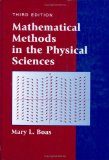 Review: Boas continues her tradition of conciseness and wholly satisfies physical science students with her third edition of Mathematical Methods in the Physical Sciences. Mathematics majors need to be aware that this book is intended for the fields of science and engineering, therefore the author’s focus is not on proofs or mathematical rigor. She even makes a point to stress this in the preface. Boas has done students a tremendous service by combining essential math concepts into one easy to use reference guide. It contains vital pieces and bits of all the major topics including Complex numbers, linear algebra, PDEs, ODEs, calculus, analysis and probability and statistics. Every physics student should certainly own this one. More info.
Review: Boas continues her tradition of conciseness and wholly satisfies physical science students with her third edition of Mathematical Methods in the Physical Sciences. Mathematics majors need to be aware that this book is intended for the fields of science and engineering, therefore the author’s focus is not on proofs or mathematical rigor. She even makes a point to stress this in the preface. Boas has done students a tremendous service by combining essential math concepts into one easy to use reference guide. It contains vital pieces and bits of all the major topics including Complex numbers, linear algebra, PDEs, ODEs, calculus, analysis and probability and statistics. Every physics student should certainly own this one. More info.
Number Theory Books
Elementary Number Theory
by Gareth A. Jones and Josephine M. Jones
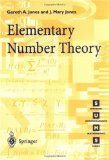 Review: Undergraduate math majors will find this book to be easily approachable but containing much depth. Jones and Jones form a powerful duo and expertly take students through a painless and surprisingly enjoyable learning experience. They seem aware that many readers prefer readability over a more pedantic style. They briefly touch base on advanced topics such as Fermat’s Last Theorem and its history while still remaining understandable. This book rightfully puts emphasis on the beauty of number theory and the authors accompany each exercise with complete solutions – something students will certainly enjoy. This book can work excellently as both introductory course literature or supplementary study and reference material. More info.
Review: Undergraduate math majors will find this book to be easily approachable but containing much depth. Jones and Jones form a powerful duo and expertly take students through a painless and surprisingly enjoyable learning experience. They seem aware that many readers prefer readability over a more pedantic style. They briefly touch base on advanced topics such as Fermat’s Last Theorem and its history while still remaining understandable. This book rightfully puts emphasis on the beauty of number theory and the authors accompany each exercise with complete solutions – something students will certainly enjoy. This book can work excellently as both introductory course literature or supplementary study and reference material. More info.
An Invitation to Modern Number Theory
by Steven J. Miller and Ramin Takloo-Bighash
 Review: Advanced undergrads interested in information on modern number theory will find it hard to put this book down. The authors have created an exposition that is innovative and keeps the readers mind focused on its current occupation. The subject of modern number theory is complex and therefore this book is intended for the more experienced student. However, the authors tackle the subject in a well-paced yet rigorous style that is more than commendable. Each page exudes brilliance, birthing an underlying deeper awareness of the topic. As described in the title this book really is an invitation – and curious readers would be wise to accept it. More info.
Review: Advanced undergrads interested in information on modern number theory will find it hard to put this book down. The authors have created an exposition that is innovative and keeps the readers mind focused on its current occupation. The subject of modern number theory is complex and therefore this book is intended for the more experienced student. However, the authors tackle the subject in a well-paced yet rigorous style that is more than commendable. Each page exudes brilliance, birthing an underlying deeper awareness of the topic. As described in the title this book really is an invitation – and curious readers would be wise to accept it. More info.
An Introduction to the Theory of Numbers
by G. H. Hardy, Edward M. Wright and Andrew Wiles
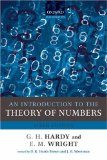 Review: This is a book that is commonly used in number theory courses and has become a classic staple of the subject. Beautifully written, An Introduction to the Theory of Numbers gives elementary number theory students one of the greatest introductions they could wish for. Led by mathematical giant G. H Hardy, readers will journey through numerous number theoretic ideas and exercises. Hardy’s writing brims with a knowledge and elegance that subtly displays the razor sharp expertise he possessed. This book will not only guide number theory students through their current studies but will also prepare them for more advanced courses should they pursue them in the future. An absolute classic that belongs to the bookshelf on any math lover. More info.
Review: This is a book that is commonly used in number theory courses and has become a classic staple of the subject. Beautifully written, An Introduction to the Theory of Numbers gives elementary number theory students one of the greatest introductions they could wish for. Led by mathematical giant G. H Hardy, readers will journey through numerous number theoretic ideas and exercises. Hardy’s writing brims with a knowledge and elegance that subtly displays the razor sharp expertise he possessed. This book will not only guide number theory students through their current studies but will also prepare them for more advanced courses should they pursue them in the future. An absolute classic that belongs to the bookshelf on any math lover. More info.
Numerical Analysis Books
Numerical Analysis with CD-ROM
by Timothy Sauer
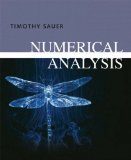 Review: Sauer has created a book that is more than suitable for first course studies in numerical analysis. He highlights the five critical areas of the subject which are: Convergence, Complexity, Conditioning, Compression, and Orthogonality, and makes well-planned connections to each throughout the book. The proofs are exacting but not too intricate and will firmly satisfy students. Each chapter is laden with insight, and not just analysis. Sauer attentively infuses his book with numerous problems, some to be completed by hand and others through the use of the Matlab numerical computing package. Complete with Matlab code in the back of the book and an accompanying CD-ROM, students will find Numerical Analysis a pleasure to own. More info.
Review: Sauer has created a book that is more than suitable for first course studies in numerical analysis. He highlights the five critical areas of the subject which are: Convergence, Complexity, Conditioning, Compression, and Orthogonality, and makes well-planned connections to each throughout the book. The proofs are exacting but not too intricate and will firmly satisfy students. Each chapter is laden with insight, and not just analysis. Sauer attentively infuses his book with numerous problems, some to be completed by hand and others through the use of the Matlab numerical computing package. Complete with Matlab code in the back of the book and an accompanying CD-ROM, students will find Numerical Analysis a pleasure to own. More info.
Numerical Recipes 3rd Edition: The Art of Scientific Computing
by William H. Press, Saul A. Teukolsky, William T. Vetterling and Brian P. Flannery
 Review: This third edition of a widely esteemed favorite has been upgraded to include the latest modern scientific computing methods as well as two completely new chapters. The book is still written and presented in the same practical an easy to read style that the previous versions were known for. The authors diligently treat the old familiar methods with passion while tactfully intertwining them with newer and equally important more contemporary ones. The exceptionally written C++ code will help readers incorporate and test the algorithmic solutions in their own environments for further learning. However there are strict licensing rules to pay attention to. More info.
Review: This third edition of a widely esteemed favorite has been upgraded to include the latest modern scientific computing methods as well as two completely new chapters. The book is still written and presented in the same practical an easy to read style that the previous versions were known for. The authors diligently treat the old familiar methods with passion while tactfully intertwining them with newer and equally important more contemporary ones. The exceptionally written C++ code will help readers incorporate and test the algorithmic solutions in their own environments for further learning. However there are strict licensing rules to pay attention to. More info.
Precalculus Books
Precalculus Mathematics in a Nutshell: Geometry, Algebra, Trigonometry
by George F. Simmons
 Review: George Simmons takes newbies and out of practice scholars alike, through a refreshing crash course in three basic mathematical practices (Geometry, Algebra and Trigonometry) in their simple but often hated form. High school graduates and others on the way to their first college calculus course will be thoroughly prepared to take on the intimidating realm of college level mathematics. Simmons shows readers just how uncomplicated and enjoyable mathematics can be – all in a transparent and fluid tone. He goes into adequate depth while still maintaining enough brevity to encourage the reader to think on their own. He cuts to the chase and afterwards leaves readers feeling capable
Review: George Simmons takes newbies and out of practice scholars alike, through a refreshing crash course in three basic mathematical practices (Geometry, Algebra and Trigonometry) in their simple but often hated form. High school graduates and others on the way to their first college calculus course will be thoroughly prepared to take on the intimidating realm of college level mathematics. Simmons shows readers just how uncomplicated and enjoyable mathematics can be – all in a transparent and fluid tone. He goes into adequate depth while still maintaining enough brevity to encourage the reader to think on their own. He cuts to the chase and afterwards leaves readers feeling capable
and well-equipped. More info.
Basic Mathematics
by Serge Lang
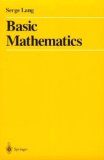 Review: The late Serge Lang’s Basic Mathematics will help students properly commence their venture into college calculus. The book is divided into four sections: Algebra, Intuitive Geometry, Coordinate Geometry, and Miscellaneous. Each section offers numerous exercises for readers to practice and fine-tune their abilities on. Lang carefully uses his grounded expertise to construct a sturdy foundation for the reader to build their future mathematical knowledge on. Basic math concepts are his sole focus and he comfortably takes readers through the material with an advanced but stress free tone. The principles Lang brings to the forefront are absolutely vital for anyone wishing to move forward in calculus, college algebra, and other areas of mathematics. More info.
Review: The late Serge Lang’s Basic Mathematics will help students properly commence their venture into college calculus. The book is divided into four sections: Algebra, Intuitive Geometry, Coordinate Geometry, and Miscellaneous. Each section offers numerous exercises for readers to practice and fine-tune their abilities on. Lang carefully uses his grounded expertise to construct a sturdy foundation for the reader to build their future mathematical knowledge on. Basic math concepts are his sole focus and he comfortably takes readers through the material with an advanced but stress free tone. The principles Lang brings to the forefront are absolutely vital for anyone wishing to move forward in calculus, college algebra, and other areas of mathematics. More info.
Probability Books
Introduction to Probability Models, Tenth Edition
by Sheldon M. Ross
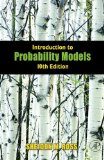 Review: Introduction to Probability Models differs from many probability books in that it covers a variety of disciplines. It has been widely used by a number of professors as the main text for many first courses. This elementary introduction provides ample instruction on probability theory and stochastic processes, and insight into its application in a broad range of fields. Ross has filled each chapter with loads of exercises and clear examples. He also takes his time in explaining the thinking and intuition behind many of the theorems and proofs. Even those who don’t specialize in the field will find it a joy to read this book. More info.
Review: Introduction to Probability Models differs from many probability books in that it covers a variety of disciplines. It has been widely used by a number of professors as the main text for many first courses. This elementary introduction provides ample instruction on probability theory and stochastic processes, and insight into its application in a broad range of fields. Ross has filled each chapter with loads of exercises and clear examples. He also takes his time in explaining the thinking and intuition behind many of the theorems and proofs. Even those who don’t specialize in the field will find it a joy to read this book. More info.
An Introduction to Probability Theory and Its Applications
by William Feller
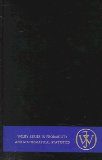 Review: In this first volume, William Feller paints a clear picture of probability theory and several of its interesting applications from the discrete viewpoint. The material is a bit advanced and is only recommended for students going into their third or fourth years. His writing brims with examples that help establish an accurate conception of discrete probability, and it includes sound insight into the history and development of probability theory. Readers will walk away with an intuitive understanding and sharper awareness of the subject. It is a must read item for any intermediate to advanced student who is working in the field of probability theory. More info.
Review: In this first volume, William Feller paints a clear picture of probability theory and several of its interesting applications from the discrete viewpoint. The material is a bit advanced and is only recommended for students going into their third or fourth years. His writing brims with examples that help establish an accurate conception of discrete probability, and it includes sound insight into the history and development of probability theory. Readers will walk away with an intuitive understanding and sharper awareness of the subject. It is a must read item for any intermediate to advanced student who is working in the field of probability theory. More info.
Probability Theory: The Logic of Science
by E.T Jaynes
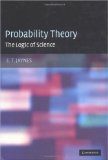 Review: Jaynes writes a fantastic prose that views probability theory beyond the usual context. The ideas found within this book are innovative and the author takes a welcomed path away from the conventional. Readers will enjoy the intellectual journey into the fundamentals of probability theory coupled with the book’s relaxed and informal tonality. It is strangely akin to receiving a one-on-one lesson from the author himself. Jaynes should be praised for taking a huge step away from mainstream probability theory and into this fresher approach. The only disappointment to this masterpiece is that, sadly, Jaynes died before completely finishing it, causing the editor to step in and thinly inject the missing pieces. More info.
Review: Jaynes writes a fantastic prose that views probability theory beyond the usual context. The ideas found within this book are innovative and the author takes a welcomed path away from the conventional. Readers will enjoy the intellectual journey into the fundamentals of probability theory coupled with the book’s relaxed and informal tonality. It is strangely akin to receiving a one-on-one lesson from the author himself. Jaynes should be praised for taking a huge step away from mainstream probability theory and into this fresher approach. The only disappointment to this masterpiece is that, sadly, Jaynes died before completely finishing it, causing the editor to step in and thinly inject the missing pieces. More info.
Fifty Challenging Problems in Probability with Solutions
by Frederick Monsteller
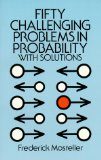 Review: This small entertaining book presents a remarkable assortment of probability problems and puzzles that will keep readers stimulated for hours. Monsteller narrates parts of his book with a sense of humor which creates an easy-going and comfortable learning environment. The problems the author has selected put emphasis on, and will help readers learn, invaluable techniques. Detailed solutions to each problem are also included so as not to leave the reader bewildered or uncertain. The book ranges in scope from basic probability puzzlers to very difficult and intricate ones for the highly advanced student. This book easily doubles as supplementary study material or as a source of recreational math enjoyment. More info.
Review: This small entertaining book presents a remarkable assortment of probability problems and puzzles that will keep readers stimulated for hours. Monsteller narrates parts of his book with a sense of humor which creates an easy-going and comfortable learning environment. The problems the author has selected put emphasis on, and will help readers learn, invaluable techniques. Detailed solutions to each problem are also included so as not to leave the reader bewildered or uncertain. The book ranges in scope from basic probability puzzlers to very difficult and intricate ones for the highly advanced student. This book easily doubles as supplementary study material or as a source of recreational math enjoyment. More info.
Real and Complex Analysis Books
Principles of Mathematical Analysis, Third Edition
by Walter Rudin
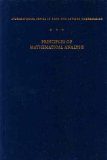 Review: Rudin has written an exquisite book on analysis. Before approaching, students should have a modest understanding of mapping, set theory, linear algebra and other basic topics. Rudin’s problem sets appear tough, but once figured out students will be more than grateful for his rigor. For readers, the key to really benefiting from this book is not only in reading it but in completing Rudin’s exercises and proofs on their own. The challenge will train them to think intuitively and effectively. This book is also known as “baby rudin” and it’s a real classic. More info.
Review: Rudin has written an exquisite book on analysis. Before approaching, students should have a modest understanding of mapping, set theory, linear algebra and other basic topics. Rudin’s problem sets appear tough, but once figured out students will be more than grateful for his rigor. For readers, the key to really benefiting from this book is not only in reading it but in completing Rudin’s exercises and proofs on their own. The challenge will train them to think intuitively and effectively. This book is also known as “baby rudin” and it’s a real classic. More info.
Real Analysis
by N.L Carothers
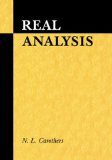 Review: There are many math books that go by the same straightforward title, however not many of them exude the same amount of mastery and reverence for the subject as Carothers’ does. The book is infused with enlightening historical commentary which keeps the reader engaged and helps break the stereotype of “boring math books”. The author also has an interesting custom of inserting a parenthesized “why” whenever he purposely bypasses a detail by forcing readers to figure it out themselves. While some will find this frustrating, motivated and determined students will take it as an opportunity to probe deeper and explore real analysis further than they normally might. More info.
Review: There are many math books that go by the same straightforward title, however not many of them exude the same amount of mastery and reverence for the subject as Carothers’ does. The book is infused with enlightening historical commentary which keeps the reader engaged and helps break the stereotype of “boring math books”. The author also has an interesting custom of inserting a parenthesized “why” whenever he purposely bypasses a detail by forcing readers to figure it out themselves. While some will find this frustrating, motivated and determined students will take it as an opportunity to probe deeper and explore real analysis further than they normally might. More info.
Real and Complex Analysis
by Walter Rudin
 Review: Rudin provides a solid handling of graduate level real and complex analysis. He encompasses all basic and advanced topics such as differentiation, Banach and Hilbert Spaces, Fourier analysis, etc. Readers who are familiar with Rudin can expect to see his usual writing style – elegant and concise. He goes through a standard but thorough teaching on measure theory in the first half of the book and then progresses onto an innovative study of complex analysis. He starts basic but fluidly moves towards a level that requires persistence on the reader’s part. This book (aka “big rudin” or “papa rudin”) is a masterpiece for students who are looking for a classic read on real and complex analysis. More info.
Review: Rudin provides a solid handling of graduate level real and complex analysis. He encompasses all basic and advanced topics such as differentiation, Banach and Hilbert Spaces, Fourier analysis, etc. Readers who are familiar with Rudin can expect to see his usual writing style – elegant and concise. He goes through a standard but thorough teaching on measure theory in the first half of the book and then progresses onto an innovative study of complex analysis. He starts basic but fluidly moves towards a level that requires persistence on the reader’s part. This book (aka “big rudin” or “papa rudin”) is a masterpiece for students who are looking for a classic read on real and complex analysis. More info.
A First Course in Complex Analysis With Applications
by Dennis Zill and Patrick Shanahan
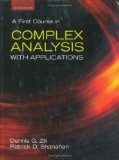 Review: This book gives students an accessible introduction to the world of complex analysis and how its methods are used. A First Course in Complex Analysis is reader-friendly to the newcomer and therefore is ideal for use by both undergrads as well as graduates. For undergrads, the authors refrain from abstractness and maintain an appreciated level of transparency. While for graduates, they effortlessly fill in the gaps that many standard course texts tend to leave wide open. Each chapter is followed by a section detailing the applications of the previously discussed topic. Additionally a quick review quiz for further verification and cultivation of skills is also included with each chapter. More info.
Review: This book gives students an accessible introduction to the world of complex analysis and how its methods are used. A First Course in Complex Analysis is reader-friendly to the newcomer and therefore is ideal for use by both undergrads as well as graduates. For undergrads, the authors refrain from abstractness and maintain an appreciated level of transparency. While for graduates, they effortlessly fill in the gaps that many standard course texts tend to leave wide open. Each chapter is followed by a section detailing the applications of the previously discussed topic. Additionally a quick review quiz for further verification and cultivation of skills is also included with each chapter. More info.
Visual Complex Analysis
by Tristan Needham
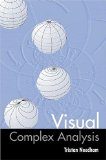 Review: Author Tristan Needham reveals the often unrealized beauty of complex analysis through a graphical perspective. He takes an elegant approach to complex analysis that will cause the reader to turn each page in awe of the insightful prose and intricate visuals. This book momentarily takes the math student’s mind off of the abstractness and conciseness that it has been raised on and transfers it to a place full of innovative approaches, but without sacrificing rigor. Readers will understand solutions through their own intuition, not memorization. Rich in math history and lively from the start, this book would make excellent study and recreational reading for the serious student. More info.
Review: Author Tristan Needham reveals the often unrealized beauty of complex analysis through a graphical perspective. He takes an elegant approach to complex analysis that will cause the reader to turn each page in awe of the insightful prose and intricate visuals. This book momentarily takes the math student’s mind off of the abstractness and conciseness that it has been raised on and transfers it to a place full of innovative approaches, but without sacrificing rigor. Readers will understand solutions through their own intuition, not memorization. Rich in math history and lively from the start, this book would make excellent study and recreational reading for the serious student. More info.
Statistics Books
Statistics in Plain English, Third Edition
by Timothy C. Urdan
Review: Just as the title implies, the author has submitted an unequivocal and palpable exposition on statistics. Statistics in Plain English is regarded by many as the most appropriate statistics primer for undergraduates. Urdan has managed to compress everything one needs to know about statistics into a compact 250 page book that doesn’t feel hurried or unfulfilling. The text is general enough to be used in a variety of mathematical areas yet retains its comprehensiveness and accuracy. Urdan masterfully moves through essential concepts without losing the reader the way many professors would. Students harboring apprehension towards statistics will tremendously enjoy this book. More info.
Introductory Statistics
by Neil A. Weiss
 Review: Introductory Statistics will greatly increase readers’ understanding of statistics and the reasoning behind the subject. Weiss has structured the subject matter carefully and formulates his writing in a lucid and enjoyable style. He thoughtfully steers away from advanced topics as they would only serve to confuse readers who are in this elementary stage. The focus is kept on detailed explanations of the basics in a clear language that will appeal to many beginners. Some of the chapters covered include: The Nature of Statistics, Organizing Data, Descriptive Measures, Discrete Random Variables, Inferential Methods in Regression and Correlation, and Analysis of Variance (ANOVA). More info.
Review: Introductory Statistics will greatly increase readers’ understanding of statistics and the reasoning behind the subject. Weiss has structured the subject matter carefully and formulates his writing in a lucid and enjoyable style. He thoughtfully steers away from advanced topics as they would only serve to confuse readers who are in this elementary stage. The focus is kept on detailed explanations of the basics in a clear language that will appeal to many beginners. Some of the chapters covered include: The Nature of Statistics, Organizing Data, Descriptive Measures, Discrete Random Variables, Inferential Methods in Regression and Correlation, and Analysis of Variance (ANOVA). More info.
Statistics, 4th Edition
by David Freedman, Robert Pisani and Roger Purves
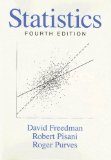 Review: This is an excellent, non-technical and simple introduction to statistics. The book is intended for lower-level students who wish to know the standard topics and methods that are included in most first statistics courses. Math students will find it easy to understand the ideas presented, while teachers and tutors will discover an engaging and highly effective way to teach statistics material. The authors provide real-life examples such as clinical trials and observational studies to help readers grasp the subject matter even better. All that is needed to learn from this book is a basic understanding of numbers and simple algebra. More info.
Review: This is an excellent, non-technical and simple introduction to statistics. The book is intended for lower-level students who wish to know the standard topics and methods that are included in most first statistics courses. Math students will find it easy to understand the ideas presented, while teachers and tutors will discover an engaging and highly effective way to teach statistics material. The authors provide real-life examples such as clinical trials and observational studies to help readers grasp the subject matter even better. All that is needed to learn from this book is a basic understanding of numbers and simple algebra. More info.
Topology Books
Introduction to Topology and Modern Analysis
by George F. Simmons
 Review: The author of this book has divided it into three sections: topology, operators, and algebras of operators. He contrives a fantastic and classical introduction to topology that targets continuity and linearity, the dominating themes. In the preface Simmons states that the goal is to illuminate these words’ meaning and their relation to each other, which is exactly what he does in the remaining pages. Self-study students will find Simmons to be a phenomenal communicator and will have no problem at all going through chapter after chapter of his writings. He clarifies deep concepts in a manner that boasts his mathematical capacity and skill while never leaving the reader behind. More info.
Review: The author of this book has divided it into three sections: topology, operators, and algebras of operators. He contrives a fantastic and classical introduction to topology that targets continuity and linearity, the dominating themes. In the preface Simmons states that the goal is to illuminate these words’ meaning and their relation to each other, which is exactly what he does in the remaining pages. Self-study students will find Simmons to be a phenomenal communicator and will have no problem at all going through chapter after chapter of his writings. He clarifies deep concepts in a manner that boasts his mathematical capacity and skill while never leaving the reader behind. More info.
Introduction to Topology: Third Edition
by Bert Mendelson
 Review: Undergraduates will enjoy this introduction to the fundamentals of topology. Despite its relatively short length, this book thoroughly encompasses the basic material students are required to know. Engaging exercises and problems urge the reader’s mind to fully comprehend and absorb the material. In the first chapter, Mendelson explains set theory in an unmitigated manner which primes readers for the following chapters. Self-study enthusiasts will fall in love with the clarity and simple progress of the writing. However, despite its simplicity this book holds much contextual depth and gravity. After Mendelson’s initial introduction to topology, students will have no need for another. More info.
Review: Undergraduates will enjoy this introduction to the fundamentals of topology. Despite its relatively short length, this book thoroughly encompasses the basic material students are required to know. Engaging exercises and problems urge the reader’s mind to fully comprehend and absorb the material. In the first chapter, Mendelson explains set theory in an unmitigated manner which primes readers for the following chapters. Self-study enthusiasts will fall in love with the clarity and simple progress of the writing. However, despite its simplicity this book holds much contextual depth and gravity. After Mendelson’s initial introduction to topology, students will have no need for another. More info.
Feel free to get in touch if you think the list is really missing out by not listing a specific book. If you are a publisher and feel that we’re missing a great book of yours, drop us a line. Please understand that we recommend only what we consider to be the best books on the market today. No exceptions.
Disclaimer: Here at MathBlog.com we believe in full disclosure. The links to Amazon.com have our referral id which earns us a tiny commission every time you buy from these links. Think of it as a tip that won’t cost you a cent, to reward us for our time investment. We appreciate your support.
